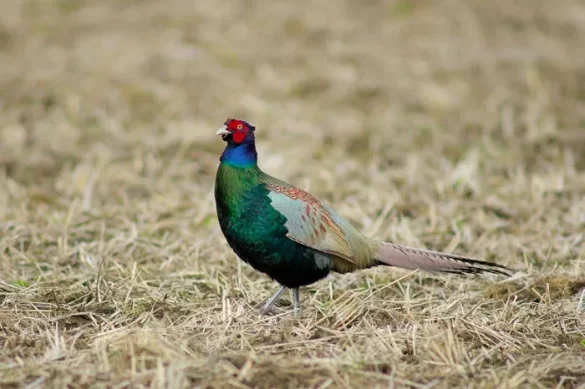The Green Pheasant, also known as the Japanese Green Pheasant (Phasianus versicolor), is a beautiful bird native to Japan. It is the national bird of Japan and holds a special place in Japanese culture and nature.
In this article, we will explore 15 interesting facts about the Green Pheasant, providing insights into its appearance, habitat, behavior, and cultural significance.
15 Interesting Facts About the Green Pheasant
1. Native to Japan
The Green Pheasant lives only in Japan. It is found on the main islands of Honshu, Shikoku, and Kyushu, as well as some smaller nearby islands. It has also been introduced to places like Hawaii and North America, but it is native only to Japan.
2. National Bird of Japan
In 1947, the Green Pheasant was designated as the national bird of Japan. Its connection to Japanese legends and traditions has elevated its importance. Known as “kiji” in Japanese, it symbolizes harmony and is seen as a cherished part of Japanese heritage.
3. Striking Appearance
Male Green Pheasants are known for their striking appearance. They have dark green plumage on their breast, neck, and flanks, a bluish-purple hood, red facial wattles, and a long, pale gray-banded tail. Females are smaller with brownish-black plumage, providing camouflage in their natural habitat.
4. Three Subspecies
There are three recognized subspecies of the Green Pheasant:
- Southern Green Pheasant (P. v. versicolor): Found in southern Japan, males have the darkest green plumage.
- Pacific Green Pheasant (P. v. tamensis): Found along the Pacific coast, males have lighter plumage with more purple and blue hues.
- Northern Green Pheasant (P. v. robustipes): Found in northern regions, males have the lightest plumage with bronze tones.
Each subspecies has slight differences in size and coloration.
5. Omnivorous Diet
Green Pheasants are omnivores. They eat a variety of foods, including insects, worms, small invertebrates, grains, seeds, and berries. This versatile diet supports their survival in diverse habitats.
6. Breeding Season
The breeding season for Green Pheasants begins in March or April and ends in June. They can start breeding at about one year old. A single clutch contains between six and fifteen eggs, which are incubated for 23 to 25 days.
7. Earthquake Sensitivity
In Japanese culture, it is believed that Green Pheasants can sense earthquakes. People have observed that these birds become agitated and make loud calls before an earthquake occurs. This behavior has contributed to their cultural significance.
8. Habitat Preferences
Green Pheasants prefer habitats such as woodlands, forest edges, brush, grasslands, and parklands. They are also commonly found near farmlands and human settlements, showcasing their adaptability.
9. Introduced Populations
While native to Japan, Green Pheasants have been introduced to other regions, including Hawaii. In Hawaii, the populations are stable. Attempts to introduce them to North America were unsuccessful, as they did not adapt well to the environment.
10. A Key Character in Japanese Folklore
The Green Pheasant appears in one of Japan’s most famous folk tales, Momotaro. The story describes a heroic boy and his animal companions, one of which is a pheasant. This tale has been passed down for generations, solidifying the pheasant’s cultural significance.
11. Role in Japanese Culture
Beyond being the national bird, the Green Pheasant holds cultural significance in Japan. It has been featured on the Japanese 10,000 yen note and is seen as a symbol of harmony, especially due to the way females walk with their chicks.
12. Conservation Status
The Green Pheasant is currently listed as “Least Concern” by the International Union for Conservation of Nature (IUCN). While the population is decreasing, it is not severely fragmented. In Japan, they are designated as one of the 29 game species that can be legally hunted with a license.
13. Unique Vocalizations
Green Pheasants are known for their distinctive calls. Males have loud, sharp calls that can be heard during the breeding season. These vocalizations play a role in attracting mates and establishing territory.
14. They Have Distinct Gender Roles
Green Pheasants exhibit strong differences between males and females, not just in their appearance but also in their behavior. Males are responsible for guarding territories and attracting mates, while females care for the eggs and chicks.
15. Symbol of Harmony
In Japanese folklore, the Green Pheasant is seen as a symbol of harmony and family unity. The sight of a mother pheasant walking with her chicks is considered a representation of familial bonds and peaceful coexistence.
Conclusion
The Green Pheasant is a remarkable bird that embodies the natural beauty and cultural richness of Japan. From its vibrant appearance and unique behaviors to its significance in folklore and national identity, the Green Pheasant continues to captivate and inspire. Understanding and appreciating these 15 facts can deepen our respect for this extraordinary species and the ecosystems it inhabits.


 Facebook
Facebook  Instagram
Instagram  Youtube
Youtube 